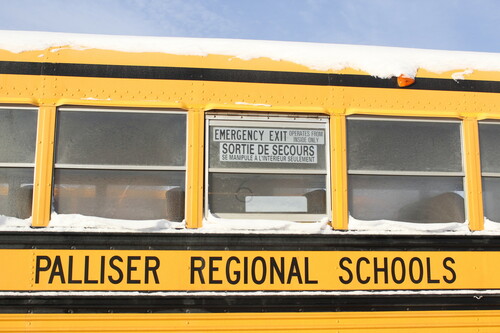
Decision to cancel busing due to weather often involves driving around in ugly conditions
The work day starts dark and early for staff in a school division transportation department.
Palliser Transportation Services Supervisor David Shaw may be found travelling highways and gravel-covered range roads before 6 a.m., often in the kind of weather that would make the rest of us want to stay at home.
Shaw was on his way to the Picture Butte area by 6:10 a.m. Jan. 8, the morning after a short-lived chinook, as an unexpected blast of winter struck a narrow swath north of Picture Butte tracking east.
There were no advisories or warnings on the weather channel to indicate any bus service would be at risk when he got a call from one of Palliser’s bus drivers saying a parent along the route had called to warn against travel.
By the time Shaw drove from Lethbridge toward Picture Butte a “mini-blizzard” was in full force. Visibility in areas north of Picture Butte was hindered, and the decision was made to cancel three routes, all serving Picture Butte schools. The cancellations were announced around 7 a.m., more than 30 minutes later than normal due to the fast-changing and localized conditions.
By the time the morning was done, 11 routes were reporting delays, one for mechanical issues, others due to road conditions. That may sound like a lot, but some were running behind by just five minutes. Another 45 Palliser routes from Coaldale to Arrowwood, north of Vulcan, ran on time without issue.
Every winter when bus service is cancelled, Palliser faces questions about how these decisions are made. The answers are found in Palliser’s Board Policy 19 (Inclement Weather) and Administrative Procedure 555 (Bus Transportation During Inclement Weather).
Yet these documents don’t quite capture the scope of networking that occurs in the critical minutes between 5 and 6 a.m. It’s a tale of neighbours talking to neighbours, office staff monitoring Internet sources, and good old first-person reports from people who “physically go out in a vehicle to see what it’s like,” Shaw said.
He said the process usually starts the night before with monitoring of forecasts and weather advisories. If the forecast calls for potentially dangerous conditions, he calls drivers to put them on warning.
Geographically diverse division has four distinct microclimates
Palliser buses serve a large area that spans roughly 200 kilometres north to south. As a result, an assessment of conditions occurs in each of four areas:
- Arrowwood, Milo and the colony schools of Riverbend, New Dale and Arrowwood at the far north;
- Brant, Vulcan, Champion and colony schools of Brant, Wild Rose and Mialta;
- Barons, Huntsville, Coalhurst, Picture Butte, Noble Central and Gold Ridge Colony;
- and Sunnyside, Coaldale and the colony schools of Lakeside, New York and Rock Lake to the south.
“There are four distinct microclimates, and the conditions can be quite different from one area to another,” Shaw said.
Shaw starts by calling seven key bus drivers and his administrative assistant who collect information from their own sources. For the drivers, this involves calling on parents near and far along their own route, as well as other bus drivers in their region, and may involve taking a drive to see for themselves. Meanwhile, Shaw’s assistant Sherrie Shears begins monitoring 511 Alberta road reports, the Weather Channel and Environment Canada for various communities.
Shaw contacts Lethbridge and Vulcan County officials, as well as Volker Stevin, the company contracted to maintain highways to get their take.
By 5:45 a.m., having heard back from the network, Shaw makes a recommendation about whether buses can safely run, and he phones the Superintendent.
Following Shaw’s advice, the Superintendent makes the ultimate decision which is then relayed by Shaw and Shears to key bus drivers across the division, who then call all other affected drivers. Each driver then begins fanning out the information by phone to each parent on the route.
While those calls are being made, Shaw calls radio stations, Coaldale Christian School and Holy Spirit School Division officials who also use Palliser bus services, and other department staff. Shears updates Palliser’s website and bus status apps, and notifies others, including principals, any spare drivers filling in for the day and the Town of Coaldale, if affected. By the time these calls start, it’s likely still only 6:15 a.m.
When bus service is cancelled, it’s cancelled for the full day. Individual bus drivers have the discretion to not run or abandon completion of the route if conditions warrant.
Aside from road conditions, routes may be cancelled if the temperature and wind chill combine for -40 C or colder.
Even then, Palliser’s practice is to keep schools open with even limited staff to ensure no child arrives at school, unaware of a closure, and is left in the cold. Following a major blizzard in December 2013, hundreds of students across Palliser arrived at school.
Individual responsibility and student safety is key
Shaw says the decision to attend school in a winter storm is very much an individual one. Employees and bus drivers can determine for themselves if roads are impassable; parents can decide to keep students home, even if the school is open.
Ultimately, the safety of students is the priority. Shaw says it’s absolutely vital that students come to school dressed for the elements. A warm bus doesn’t stay warm long if it encounters mechanical issues.
As Shaw settled back in the office after the morning’s events, the snow in Lethbridge had stopped and the sky was beginning to clear.
“There’s only 71 days till the start of spring,” he said.

